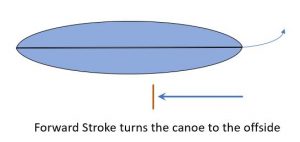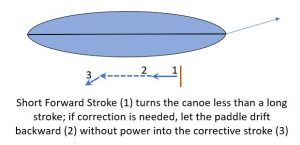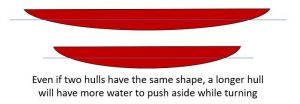by Marc Ornstein
This article is meant for paddlers who want to understand and improve control of their craft. Physicists and naval architects likely can demonstrate exceptions. So be it.
Concept #1
The canoe will go straight unless the paddler (or some other force) throws it off course.
Concept #2
For every action there is an equal but opposite reaction. This entire article is based upon this principle. When you pull or push against the water with the paddle, you create a force or forces. You and the canoe respond in predictable ways to those forces
Concept #3
Canoes (and most other boats) steer from the trailing end (stern when traveling forward). That is, they turn much like wheelbarrows. The leading end stays put (or nearly so), like the wheelbarrow wheel and the trailing end (handles), rotates around it.
Concept #4
A short canoe turns more easily than a long canoe. (Length being measured at the waterline and all other factors being equal).
Concept #1
Canoes (apart from those with physical deformities) are symmetrical, from side to side. They are relatively long, skinny, and pointy at both ends. Even so-called asymmetrical canoes are so from end to end, but are still symmetrical from side to side. If you place such a craft in a perfectly still body of water (no wind and no current) and push it perfectly straight ahead, it will continue to travel straight ahead until surface friction, air resistance etc. rob it of momentum and it stops.
 The problem lies in that pushing it straight ahead, with a paddle, is nearly impossible. The paddle being offset to one side of the canoe exerts more force on that side, causing the canoe to turn away from it. We refer to that turning (away from the paddle) as yaw. There are ways to minimize yaw;
The problem lies in that pushing it straight ahead, with a paddle, is nearly impossible. The paddle being offset to one side of the canoe exerts more force on that side, causing the canoe to turn away from it. We refer to that turning (away from the paddle) as yaw. There are ways to minimize yaw;
- Keep the paddle blade as close to the side of the canoe as possible throughout the stroke and move the blade directly front to back, parallel with the keel line rather than following the curve of the hull. Following the curve of the hull, imparts other (turning) forces. Your grip hand/arm should extend outward, past the gunwale such that the paddle shaft is as vertical as possible. If the grip hand is inward of the gunwale, the paddle shaft will be angled outward (blade farther from the hull, much like a sweep), thereby increasing the turning forces.
- Keep the blade perpendicular to the centerline (sometimes called the keel line) of the canoe. An angled blade imparts various deflecting forces that push the canoe to the side or cause it to turn.
Concept #2
Hopefully, you have a vague memory of a guy named Issac Newton. He was a physicist, mathematician, astronomer etc. back in the 1600s. He developed several theories that have become known as Newton’s Laws of Motion. In short and simplified description, his 3rd law of motion stated that for every action, there is an equal but opposite reaction.
- If one creates a force (with the paddle) that is applied directly front to back, the canoe will move directly forward. Thus, if the canoe had a slot down the middle through which one could insert the paddle and pull it straight back, this might be possible. Such a slot is impractical so we are forced to offset our paddle to one side or the other. This imparts unequal forces creating yaw as described earlier.
Concept #3
As we have already established, the paddle being offset to one side will necessarily create some yaw. As we also have established, the canoe steers primarily from the rear (trailing end). If one wants to go straight, both factors should be kept in mind.
- In taking a stroke, power should be applied as far forward as practical. Keep the stroke short and do not carry power beyond the point where the blade passes your knee. The canoe is like a lever (think of an old-fashioned seesaw). The fulcrum (the pivot point of that lever) is generally just forward of the seat, in solo canoes and near the center of the canoe in tandems. Once the paddle gets behind the pivot point (closer to the rear where most steering occurs) while still being powered, it can easily throw the canoe off course.
- Once the paddle p
 asses your knee it should be allowed to “drift” as far back as one can comfortably reach before applying any corrective force (J stroke etc.) The farther back the blade is carried, the less force that will be required to nudge the stern back in line or to affect a desired turn.
asses your knee it should be allowed to “drift” as far back as one can comfortably reach before applying any corrective force (J stroke etc.) The farther back the blade is carried, the less force that will be required to nudge the stern back in line or to affect a desired turn.
Concept #4
When traveling straight ahead, the pointy ends of the canoe easily part the water, slicing through it like a knife blade. Turning the canoe requires the relatively flat sides of the craft to push water aside, demanding significantly more force.
- The longer the canoe, the more water it must push aside when turning. Thus, (with some exceptions) a short canoe turns more easily than a long canoe. Conversely, a longer canoe will resist turning (track straighter) than a short canoe. Additionally (again thinking about the canoe like a seesaw) the farther the paddler is from the stems, the less leverage he/she can apply toward pushing them sideways.
-
- Adding a bit of rocker (think banana shape) to the bottom of the canoe causes the stems to ride higher in the water, thus less water needs to be pushed aside, allowing the canoe to turn more easily.

- A larger volume canoe will sit higher in the water than a smaller volume canoe (given the same payload) and thus will turn more easily. Conversely, a heavily loaded small volume canoe will sit deeper in the water and be more difficult to turn.
Wind Wave and Currents
As mentioned above, several times, there are factors at play, other than those we control. They are, most notably, wind, waves, and currents. It is a rare time that one or more of them don’t come into play to at least a small extent, and often quite significantly. A skilled paddler is aware always aware of them and compensates accordingly. Accurately reading/interpreting the water and the wind is an entire skillset of it’s own and perhaps the subject of a future article.